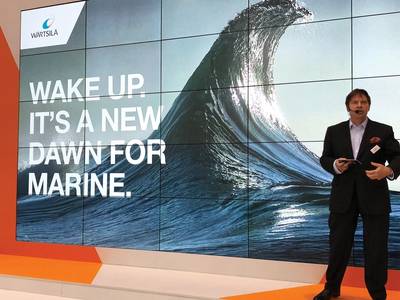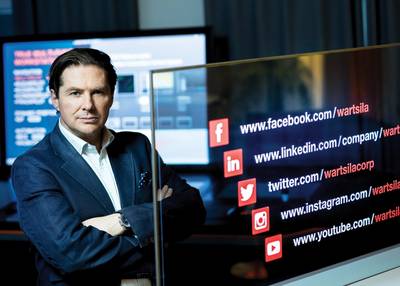Marco Ryan Plots a Digital, Connected Course for Wärtsilä
When talk turns to the digital revolution sweeping through the maritime industry, one need look no further than Wärtsilä, which has evolved from a shipbuilding company to an engine manufacturer, and is now embarked on a historic digital transformation led by Marco Ryan, Chief Digital Officer & EVP. We met with Ryan recently in Hamburg, Germany, to discuss the path and pace forward.
To start, please lay out the scope of your responsibilities.
At a high-level my job is to architect and deliver the transformation (of Wärtsilä) to a smart technology company. My specific responsibilities include cyber security, all of IT, all of the innovation, processes and capabilities, including working with startups and all digital product development. All of that translates into ‘How do we drive value for customers through digital?’ There are lots of levers that we can pull, and my job is to make sure that those five or six levers get pulled together in the right way to deliver outcomes that are tangible and real.
The terms “big data” and “digitalization” are overused. What do they mean to you?
I think it starts with a couple of principles: it’s about pace and collaboration. So there are opportunities, and digitalization or big data are tools which allow you to get to an outcome. The outcome has to have value for the industry, and you can’t do it alone.
So the first thing is it delivers something typically at pace and at scale that you can’t do without the technology. I think one of the risks is that a lot of people talk the buzzwords but don’t actually work out how to use them to derive outcomes. There’s a lot of activity in digital: and it can be a very expensive mistake if you’re not focused on how you pull things together.
For our industry it’s about efficiency – whether that’s around fuel efficiency or time to value in terms of, you know, getting container from port to port. It’s about safety – whether that is crew safety or a passenger safety, it’s about environmental impact. And it’s also about sustainability – sustainability of their business and sustainability of the environment. So those are three themes (efficiency, safety and sustainability) that are specific to the marine industry.
What is the challenge of being an engineering company in the digital age?
Any established company – whether it’s Wärtsilä or somebody else – that’s being optimized for the world that it currently lives in, needs to be challenged into change, into something that tends to be much more value-based. We have some of the most talented engineers in the business, and we are by nature an innovative company. We change every generation: two generations ago, we were shipbuilders; a generation ago, engine manufacturers; and now a smart technology company. So we are, perhaps, one of the most agile, changeable companies that I’ve come across. I think the challenge with an engineering product-driven company is the proof points. So it’s “Tell me what this outcome’s going to be delivered, how safe is that outcome, and then I’ll change.” The challenge with the digital transformation is that all of it is hypothesis-driven: “what if we” and “let’s test and learn” and “let’s see how quickly we can prove whether that works.”
So we created innovation spaces, environments, where we can incubate – make it safe – give people all the new skills and mentoring, coaching and capabilities, and ask them to bring their business issues in. Then we collaboratively work on the business issues to derive a different solution or outcome. Typically (it’s issues) they’ve struggled to solve over time, and they find that a new way of working helps to derive an outcome much quicker, while creating enormous emotional connection with the new world.
 Marco Ryan presenting Wärtsilä's new vision at SMM 2018 in Hamburg. (Photo: Greg Trauthwein)There are two key planks in the Wärtsilä transformation, Smart Marine & Smart Energy. What are they?
Marco Ryan presenting Wärtsilä's new vision at SMM 2018 in Hamburg. (Photo: Greg Trauthwein)There are two key planks in the Wärtsilä transformation, Smart Marine & Smart Energy. What are they?
Well, they’re both driven by – I know it’s a buzzword but we believe it – ecosystem thinking. So this is looking at the end-to-end value chain and asking “where do we play a primary role,” though traditionally in marine that would probably be in, onboard a vessel, that’s engines and automation systems and navigation. And also asking “where do we need to play an expanded or new role,” and that’s much more lateral; that’s much more about into the ports, into the cities.
Now in energy, we’ve said both visions are driven by a similar thing: if you have great technology and a deep understanding of the market sector, you can apply that in different ways – with new business models, with collaboration, with new ways of working – to create new opportunities. So we’re taking the data, the insights, and we’re trying to then explore how we go laterally, how we go into those secondary areas, to create new value propositions to help the organizations change.
Smart energy is slightly more advanced than smart marine, because the sector is already massively disrupted and a lot of the disruption has happened and the appetite and the need to change is there. Marine is a little bit more incubated and perhaps a little bit slower, but it doesn’t mean that the journey isn’t happening.
What are some real case examples of current marine industry transformation?
We’ve done a lot of innovation around safety visualization, using real-time data and virtual reality with one of the large cruise liners, taking real data and giving them visualization so they can look at sort of “man overboard and safety aspects.” So that’s one example of co-creation innovation with a customer. In another we are taking our existing product set and showing what happens if you connect them together and drive efficiency and optimization. We did a trial in the Mediterranean, and we also did a trial between Rotterdam and New York where we saw double-digit fuel savings. Significant, this is real, in-hand money.
And then there are examples where we’re taking forward-looking technologies and bringing them together to create new opportunity. We have taken hybrid propulsion, mixed it with situational awareness and dynamic positioning to create an auto docking capability. So if you mix that with things like induction charging, as the vessel comes alongside, about 10 meters out, we are already recharging the vessel before it ‘arrives.’ That creates faster turnaround for the ferry. That’s a real-life pilot that we’ve done 14 times with consistent results.
One of the things that is typical of Wärtsilä is that we want to demonstrate tangible outcomes. We don’t want to just talk the hype. This isn’t about a vision of automated vessels and autonomous shipping, it’s about saying, ‘Where is the value to the customer if you bring technology together, if you underpin it with something new, what happens, and what value does it create.’ Each of those cases has a bottom line number attached to it.
Wärtsilä recently announced the Smart Technology Center. What is the vision?
It’s starting now – the doors will open in 2020 – and it is effectively relocating from the city center of Vaasa all of our manufacturing capabilities: the factory, the lab, everything – into a new campus, still in Vaasa, where we have physical space for suppliers, for customers, for academia, to come and co-locate. So we’ll be doing R&D collaboratively, we’ll be doing supply chain logistics, smart manufacturing real-time integration into supply chains, robotics, creating new ways of working.
You recently announced SEA20 – 20 cities globally, one purpose. Please explain.
This was really inspired by our purpose, enabling a sustainable society with smart technology. We looked and said ‘we have a smart marine vision’ – which is really about optimizing that ecosystem in the marine world. It starts with our knowledge of our products and our customers, what they want and where they’re changing. But, you know, all these countries, all the conversations are around changing regulations, around environmental impact. We are all aware of the legacy we’re leaving our children – or not leaving our children.
If you combine that with Smart Energy – which looks to 100% renewables future – we are well-positioned to drive and accelerate that change.
This is a digital mindset, the service design approach, and it’s asking “What are the end needs? Who is the ‘customer’ and what are their needs?’ The customer (in this case) is the citizen, the city, the environment; it’s not just Wärtsilä’s existing customers.
If we look at our customers’ customers, where they live and how they work, we’ve got to take a view that looks globally and much more futuristically, and it’s has to be absolutely embedded with a belief around our purpose: sustainable societies. The smart technology is part of the ‘how’: How you scale and how you do it quickly.
That was the starting point. Then we had some envisioning workshops where we came up with a hypothesis. That hypothesis was tested with a couple of key stakeholders and (through much work and collaboration) culminated in this Oceanic Awakening. SEA20 is a key component of that because we believe that the marine ecosystem does not just exist on the water: it has to exist as part of the port, and the ports are part of cities.
One important thing we realized was that, particularly regarding SEA20, this is not Wärtsilä’s voice. This is not a project. This is not a program. This is not an investment opportunity. This is really a movement that says, ‘We – and many other people – need to come together.’ And nobody at the moment is asking for that conversation or facilitating it, so rather than say ‘what a shame,’ we said ‘let’s do something about it; let’s be bold.’ I mean it’s a risk, right? Wärtsilä, the engine company, talking about SEA20 and the Oceanic Awakening –that’s different. But it’s something we’re passionate about, and it’s something that we really believe in. It’s a very different Wärtsilä from two years ago.
Watch our interview with Marco Ryan here.
Read the full edition of Maritime Reporter & Engineering News, October 2018, here.















